In QOLO at Department of Optics (Faculty of Science, Palacky University in Olomouc) we are focused on quantum information processing and quantum optics. We use single photons, linear and nonlinear optics and electrooptical control of light to encode and manipulate information. We explore non-classical aspects of light signals through direct measurement as well as using quantum tomography based on maximum likelihood principle, which was originally developed for quantum regime at our department. Our research pursues theoretical aspects of non-classicality and its detection, theoretical as well as experimental aspects of preparation and detection of quantum states of the light, and employing them as information carriers in future quantum computers.
RECENT RESEARCH PROJECTS
Noiseless loss suppression in quantum optical communication
We proposed a protocol for conditional suppression of losses in direct quantum state transmission over a lossy quantum channel. The method works by noiselessly attenuating the input state prior to transmission through a lossy channel followed by noiseless amplification of the output state. The procedure does not add any noise hence it keeps quantum coherence. We demonstrated this protocol experimentally in the subspace spanned by vacuum and single-photon states, and considered its general applicability [Phys. Rev. Lett. 109, 180503 (2012)].
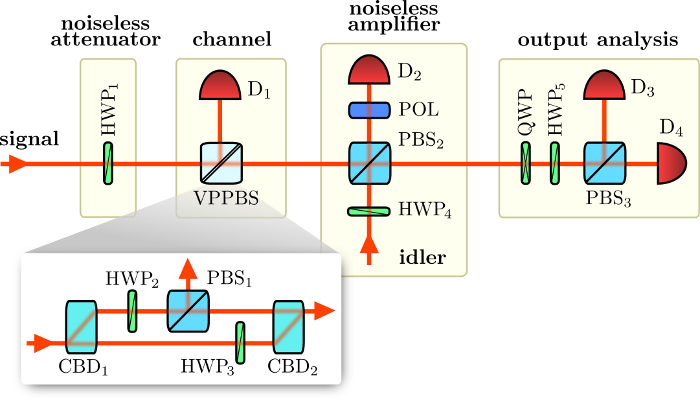
Experimental test of quantum non-Gaussianity
We reported on experimental verification of quantum non-Gaussianity of a heralded single photon state with positive Wigner function [Phys. Rev. Lett. 107, 213602 (2011)]. We unambiguously demonstrated that the generated state cannot be expressed as a mixture of Gaussian states. A sufficient information to witness the quantum non-Gaussianity was obtained from a standard photon anti-correlation measurement. Our approach is based on the non-Gaussianity criterion devised by Radim Filip and Ladislav Mišta [Phys. Rev. Lett. 106, 200401 (2011)].
Further, in collaboration with QUIN group of prof. Ulrik Andersen we have experimentally verified the quantum non-Gaussian character of a conditionally generated noisy squeezed single-photon state with a positive Wigner function [Phys. Rev. A 86, 043813 (2012)]. Employing an optimized witness based on probabilities of squeezed vacuum and squeezed single-photon states, we have proven that the state cannot be expressed as a mixture of Gaussian states. In our experiment, the non-Gaussian state was generated by conditional subtraction of a single photon from a squeezed vacuum state. The state was probed with a homodyne detector and the witness was determined by averaging a suitable pattern function over the measured homodyne data.

Logic gates programmable by single photons
The primary focus of the project was to build quantum logic gates programmable by single photons as a building blocks of quantum computers. Particularly, the phase-shift gate with single-quantum-bit program and the sign-flip gate programmable by fully quantum software were developed. The former applies a unitary phase shift operation to a data quantum bit (qubit) with the value of the phase shift being fully determined by the state of a program qubit [M. Mičuda, M. Ježek, M. Dušek, and J. Fiurášek, Experimental realization of a programmable quantum gate, Physical Review A 78, 062311 (2008)]. The latter applies a sign flip operation to data qubit in an arbitrary basis fully specified by the quantum entangled state of a two-qubit program register [L. Slodička, M. Ježek, and J. Fiurášek, Experimental demonstration of a teleportation-based programmable quantum gate, Physical Review A 79, 050304(R) (2009)].
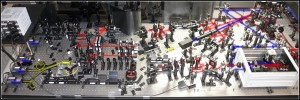
Our experimental implementation was based on the encoding of qubits into polarization states of single photons, multiphoton interference, and photon coincidence detection. Linear and non-linear bulk as well as fiber optics components were employed during the realization. Particularly, sign-flip gate was built almost completely using optical fibers that enables trasferring the gate onto optical chips. Functionality of the new gates was demonstrated with fidelity higher than 97% for single-qubit-program gate and 90% for two-qubit-program gate. The realized devices were characterized thoroughly using quantum tomography.
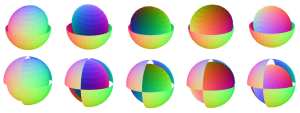
Visualization of quantum teleportation (first column) and sign-flip gate for different program states. The outer shell stands for the input qubit and its various possible states represented by a color distribution. The inner shell visualizes the action of the gate by color changes depending on the program. Deformations come from experimental imperfections which degrade the gate operation.
In 2011, we employed a fast electronic feed forward to increase the success probability of a linear optical implementation of a programmable phase gate from 25% to its theoretical limit of 50% [Phys. Rev. A 85, 012305 (2012)]. The feed forward applies a conditional unitary operation which changes the incorrect output states of the data qubit to the correct ones. The signal from the feed-forward detector is led directly to a phase modulator using only a passive voltage divider. The gate implementation is based on fiber optics components, qubits are encoded into spatial modes of single photons within . We verifi ed the increase of the success probability and characterized the gate operation by means of quantum process tomography. We demonstrated that the use of the feed forward does not aff ect either the process fidelity or the output-state fidelities. The feed forward loop is now routinely used in our lab to keep the succes rate of QIP protocols at its theoretical maximum.
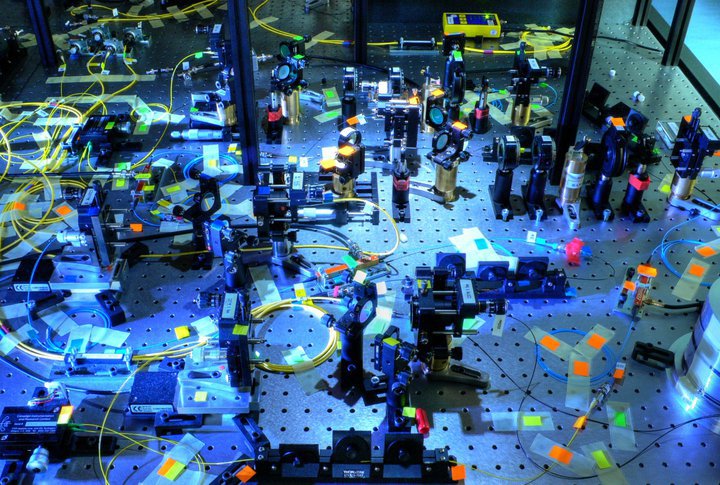
Photo detectors
Photo detectors capable to detect single photons are crucial for further development of quantum optics, quantum information and quantum communication. For many application the detector has not only to reach superior parameters of quantum efficiency, speed, low noise etc but has to possess highly non-classical properties such as photon number resolving (PNR) capability. In general, single PNR detector is able to distinguish between N and N+1 photons in the incident light signal at least up to some maximum high enough photon number. The perfect resolution is out of reach of the current technology and even approximate PNR detection represents a serious challenge.
We have developed a balanced eight-port PNR multichannel detector based on an optical-fiber time-multiplexed device with the unique total optical transmittance reaching 93% and a pair of avalanche photodiodes in Geiger regime [M. Mičuda, O. Haderka, and M. Ježek, High-efficiency photon-number-resolving multichannel detector, Physical Review A 78, 025804 (2008)].
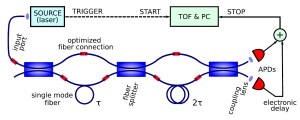
The balanced operation means that input signal is divided into the output eight temporal detection channels with more less equal probability. This is achieved even for imperfect unbalanced fiber splitters used in the time-multiplexed device. We have shown high-speed photon counting at the rates of 100 kHz with the total detection efficiency exceeding 50%. The multiplex based design is convenient and robust but suffers from crosstalks and trade-off between maximum detectable photon number and maximum possible repetition rate. Other PNR techniques have to be devised for high-speed applications.
Balanced homodyne detection represents another feasible way how to measure the photon content and even optical phase of the incident light pulse. Mixing with reference coherent mode-matched local oscillator (LO) pulse with variable phase gives rise to an interference and it reveals the amplitude and phase structure of the measured quantum state of the pulse.
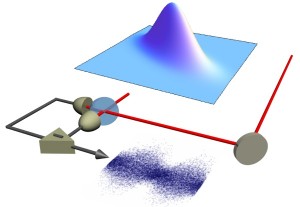 We have built and tested two different time-domain homodyne detectors. First based on a transimpedance amplifier with bandwidth from DC to 40 MHz [O. Haderka, V. Michálek, V. Urbášek, and M. Ježek, Fast time-domain balanced homodyne detection of light, Applied Optics 48, 2884 (2009)]. It gives up to 12 dB signal-to-noise ratio for 40 MHz repetition rate 150 fs pulse train with average LO power around 10 mW (almost 10^9 photons per pulse). Further, we have utilized the original Amptek-based charge-sensitive design with some minor changes, particularly better bias filtering and balancing. The detector exceeds 30 dB signal-to-noise ratio for several tens micro W of LO power and works very stable at 25 dB for 20 micro W LO with repetition rate of 0.8 MHz and 5 ps pulse length (100 mio photons per pulse). The bandwidth spans an interval from approximately 100 Hz to 2 MHz at least. The detector works at 1.6 MHz repetition rate without any change in performance. The latter time-domain 30 dB homodyne detector is used in Quantum information group of prof. Ulrik L. Andersen at Department of Physics of Technical University of Denmark for preparation of free-running non-classical states of light, phase super-resolution [Phys. Rev. Lett. 111, 033603 (2013)], quantum computing with optical Schrodinger cat states [Phys. Rev. A 84, 050301(R) (2011)] and for other applications.
We have built and tested two different time-domain homodyne detectors. First based on a transimpedance amplifier with bandwidth from DC to 40 MHz [O. Haderka, V. Michálek, V. Urbášek, and M. Ježek, Fast time-domain balanced homodyne detection of light, Applied Optics 48, 2884 (2009)]. It gives up to 12 dB signal-to-noise ratio for 40 MHz repetition rate 150 fs pulse train with average LO power around 10 mW (almost 10^9 photons per pulse). Further, we have utilized the original Amptek-based charge-sensitive design with some minor changes, particularly better bias filtering and balancing. The detector exceeds 30 dB signal-to-noise ratio for several tens micro W of LO power and works very stable at 25 dB for 20 micro W LO with repetition rate of 0.8 MHz and 5 ps pulse length (100 mio photons per pulse). The bandwidth spans an interval from approximately 100 Hz to 2 MHz at least. The detector works at 1.6 MHz repetition rate without any change in performance. The latter time-domain 30 dB homodyne detector is used in Quantum information group of prof. Ulrik L. Andersen at Department of Physics of Technical University of Denmark for preparation of free-running non-classical states of light, phase super-resolution [Phys. Rev. Lett. 111, 033603 (2013)], quantum computing with optical Schrodinger cat states [Phys. Rev. A 84, 050301(R) (2011)] and for other applications.


